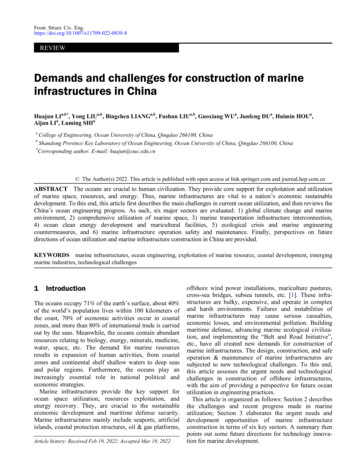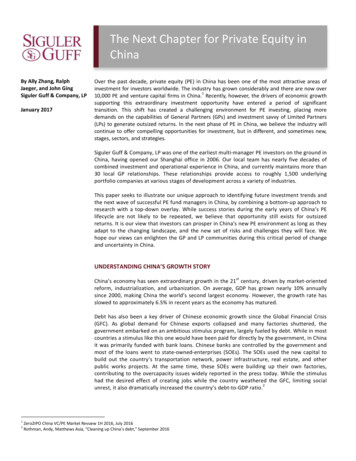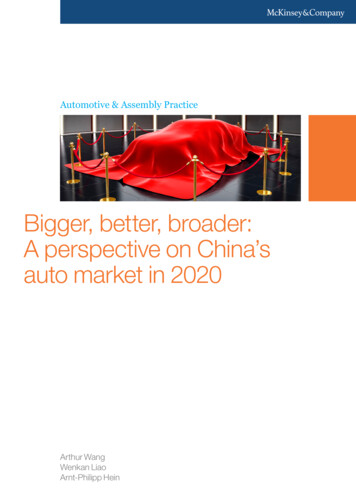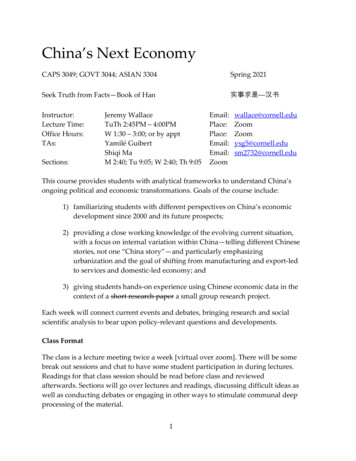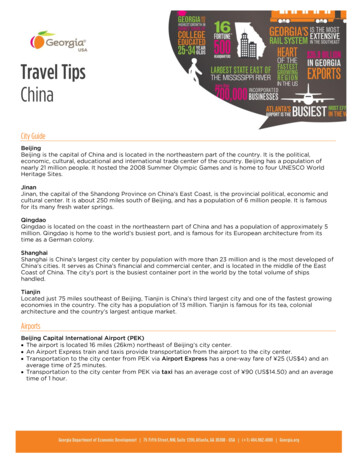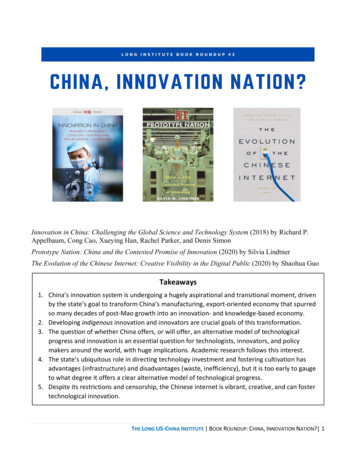
Transcription
Innovation in China: Challenging the Global Science and Technology System (2018) by Richard P.Appelbaum, Cong Cao, Xueying Han, Rachel Parker, and Denis SimonPrototype Nation: China and the Contested Promise of Innovation (2020) by Silvia LindtnerThe Evolution of the Chinese Internet: Creative Visibility in the Digital Public (2020) by Shaohua GuoTakeaways1. China’s innovation system is undergoing a hugely aspirational and transitional moment, drivenby the state’s goal to transform China’s manufacturing, export-oriented economy that spurredso many decades of post-Mao growth into an innovation- and knowledge-based economy.2. Developing indigenous innovation and innovators are crucial goals of this transformation.3. The question of whether China offers, or will offer, an alternative model of technologicalprogress and innovation is an essential question for technologists, innovators, and policymakers around the world, with huge implications. Academic research follows this interest.4. The state’s ubiquitous role in directing technology investment and fostering cultivation hasadvantages (infrastructure) and disadvantages (waste, inefficiency), but it is too early to gaugeto what degree it offers a clear alternative model of technological progress.5. Despite its restrictions and censorship, the Chinese internet is vibrant, creative, and can fostertechnological innovation.THE LONG US-CHINA INSTITUTE BOOK ROUNDUP: CHINA, INNOVATION NATION? 1
China, Innovation Nation?export-oriented economy that spurred so manydecades of post-Mao growth to a world-leadingBrian Spiveyinnovative, knowledge-based economy–in otherwords, “from ‘made in China’ to ‘designed andFor the UCI Long US-China Institute’s second Book created in China’” and “from imitator to innovator”Roundup, I covered three recently published(22). The Chinese state is, unsurprisingly, thebooks about China’s involvement in Africa, where principal architect and driver of this economicit has become the continent’s largest tradingtransition. A key policy framework for this plannedpartner, bilateral creditor, and infrastructuretransition is the 15-year Medium to Long-Termfinancer. Those books complicated sensationalist,Plan for the Development of Science andoften politically driven narratives that try to paintTechnology (MLP) that began in 2006 and wasChinese investment in Africa as either categorically aimed at cultivating “indigenous innovation”good or bad. They also revealed a growing (zizhu chuangxin) in a wide variety of highacademic field of China-Africa studies centered on technologyfields,likelifesciences,trying to understand and describe the new political, nanotechnology,cleanenergy,andsocial, cultural, and economic configurations thatsupercomputing (to name a few). However,arise out of China’s involvement in the continent.despite the state’s centrality in guiding science andThis third Book Roundup looks at another quicklytechnology development in China, it would begrowing field of research with similarly broadoverly simplistic to describe innovation therepolitical implications: China and technological merely as “state-led.” Multinational corporationsinnovation.and Chinese firms play a significant role in researchCommon tropes of China’s relationship to and innovation as do market forces. The risk then,technology and science is that China lacks systemic according to Appelbaum et al., is whether atechnological innovation, relies primarily on balance can be maintained—or if the privilegescopying and imitating the innovations of others given to the institutions behind state-led(usually in the “West”), and that ham-fisted innovation will ultimately lead to thecensorship and regulation—especially in the marginalization of “the more technologicallydigital sphere—will handicap Chinese innovation dynamic sectors in society” (92).and preserve the nation’s “backwardness." These Appelbaum et al. argue that the state’s massivetropes are usually employed to denigrate Chinese investment in science and technology—despitescience and technology and, often at the samesome “promising trends”—has not yet paid itstime, to downplay the perceived threat it poses toanticipated “big dividends.” What are some ofAmerican global technological hegemony. Below, Ithose promising trends? For one thing, thelook at three recent books that provide somemassive amount of money invested through theimportant nuance to these often reflexively MLPhasyieldedworld-classscientificemployed mantras.infrastructure in the form of cutting-edgelaboratories, research stations, instruments, andand Technology System (2018) by Richard P. facilities—though the authors note that facilitiesAppelbaum, Cong Cao, Xueying Han, Rachel Parker, alone do not innovations make. Another promisingand Denis Simon is an in-depth evaluation of trend, depending on your perspective, is theChina’s effort to transition from the manufacturing, relatively unfettered access to big data thattechnology firms in China enjoy, unburdened byInnovation in China: Challenging the Global ScienceTHE LONG US-CHINA INSTITUTE BOOK ROUNDUP: CHINA, INNOVATION NATION? 2
privacy concerns (though a recent court-ruling inChina has raised questions about whether publicpushback in China will finally establish some limits).This is a particularly stark advantage in the realmof artificial intelligence, as Chinese firms canacquire and use huge datasets much more quicklythan international competitors.On the other hand, China’s innovation systemfaces some daunting obstacles: a scientific braindrain, inefficient distribution of funds, andwastefulness. Technology firms are also moreprone to spend effort cultivating ties with thebureaucracies managing science and technologythan on the innovations themselves. Moreover,the state’s oft-changing policies continue toaccrete on top of one another, creatinginstitutional uncertainty for small and mediumsized entrepreneurs and a more favorableenvironment for state-owned enterprises (SOEs).Innovation in China gestures to the fact thatChina’s innovation system is undergoing a hugelyaspirational and transitional moment—it is helpfulfor understanding the Chinese government’sbroad intent, goals, and early returns, but thedesignations “success” and “failure” cannot yet beplaced.Silvia Lindtner’s Prototype Nation: China and theContested Promise of Innovation (2020) is anethnographic study of the global community ofinnovators and tinkerers that were searching forand found represented in China—specifically thecity of Shenzhen—“a place to prototypealternatives to existing models of moderntechnological progress” (6). The essential value ofthis “maker movement” is the idea that the makingof technology can be democratized (and thus alsothe ownership of that technology) and so functionas a way to “intervene at scale” againstexploitation and injustice. The principal target oftheir critique is the dominant, capitalist, neoliberalAmerican-centric systems of innovation found inplaces like Silicon Valley—where the vast majorityof us merely figure as consumers of technologyand not as makers. The maker movement is aresponse to the broadening realization that thedisruptive promise of the U.S. tech industry(especially in the 1990s) has been mostlyunfulfilled and that Silicon Valley was complicit inthe “loss of control, vulnerability, and insecurity”fundamental to contemporary capitalism—cumulatively what Lindtner calls a “techno-crisis”(11).How did Shenzhen, long pilloried as the capital ofshanzhai (fake goods and knockoffs) and as SiliconValley’s “unimaginative counterpart,” come to beseen as a realm of new possibilities andalternatives by tech innovators and investorsaround the globe? “Exactly” Lindtner argues,“because it was construed as ‘other’ than the West,i.e., because it was seen as a site of fakes, copies,violations of IP regulations and copyright law, andlax rules of law and regulations writ large” (16).What made the Shenzhen maker culturedistinctive was that it encouraged people to“become entrepreneurial” and in so doing developa “feeling of intervention and agency” that analternative was possible. The CCP, though, had adesire to appropriate these maker ideals and theirattendant feelings in order to develop a national,indigenous innovation economy that can engineerChina’s national rejuvenation, a goal which revealsthe “CCP’s own neoliberal agenda” (43). As such,the feelings of intervention and agency just servedto mask underlying “racism and colonial othering,sexism, gender discrimination, old and new formsof labor exploitation, and the spread of precariousconditions of work and life” inherent in neoliberalcapitalist expansion and technological promise(216).In The Evolution of the Chinese Internet: CreativeVisibility in the Digital Public (2020), Shaohua Guoargues that one of the more innovativetechnological spaces in China is the internet—despite our tendency to associate it with the“Great Firewall of China” and draconiancensorship. The authoritarian nature of Chineseinternet governance is, of course, true, but theTHE LONG US-CHINA INSTITUTE BOOK ROUNDUP: CHINA, INNOVATION NATION? 3
binary classification of internets as either open orclosed obscures just how vibrant the Chineseinternet is. How can creativity and innovationpersist in such a restricted and policed ecosystem?Guo tracks the development of four popularinternet platforms in China—“the bulletin boardsystem, the blog, the microblog, and WeChat”(230)—to reveal a competitive digital marketwhere old and new players must “continuouslyreinvent themselves” to stay in the game (233).Guo develops a concept that she calls “thenetwork of visibility” to provide a more nuancedand “ambivalent” analysis of what drives thevibrancy of China’s digital sphere. This “network ofvisibility” refers to how different players in thedigital sphere—the state, media firms,corporations, individuals—compete with oneanother for “user attention, content authority, andmarket share” (10). In other words, the internet isnot a perfect reflection of the type of discoursedesired by the state, as regulated through itsconsiderable tools of censorship and surveillance.The reality is far more negotiated and nuanced.The popular social media and lifestyle platformWeChat, for example, has a great number of selfpublished public accounts that “decentralize theprocess of content production” and that allowindividual users to blog or share their thoughts ona wide range of topics (203). In short, Guodescribes a vibrant, exciting, and creative ns about whether China’s internetwill either lead to the CCP’s downfall and China’sdemocratization or—increasingly—if it willactually be a tool to strengthen Xi’s authoritariangrip instead.Recognizing the discursive dominance of the U.S.China “tech war” goes some way in explaining thetitles and subtitles that frame many of the otherrecent publications about China and technology,like Kai-fu Lee’s AI Superpowers: China, SiliconValley and the New World Order; Rebecca Fanin’sTech Titans of China: How China’s Tech Sector isChallenging the World by Innovating Faster,Working Harder, and Going Global; or WinstonMa’s The Digital War: How China's Tech PowerShapes the Future of AI, Blockchain andCyberspace. The broader ongoing “decoupling” ofChina and the U.S. will surely encourage simplecharacterizations of rivalrous U.S. (or Western)and Chinese systems, like closed vs. open,innovative vs. backward, and freedom vs.unfreedom. Recent academic studies abouttechnological innovation in China show that, asalways, the picture is much more complicated.The United States and China are now engaged inwhat the Biden administration has characterizedas “extreme competition” in a range of strategicarenas. As the 21st century unfolds, arguably nostruggle is more important than the tussle forglobal leadership and top spot in the value chain ofadvanced scientific and high-tech industries.THE LONG US-CHINA INSTITUTE BOOK ROUNDUP: CHINA, INNOVATION NATION? 4
For more information on innovation and tech in China, check out the following recent publicationsand links:AI Superpowers: China, Silicon Valley, and the New World Order (2018) by Kai-Fu LeeTech Titans of China: How China’s Tech Sector is Challenging the World by Innovating Faster, WorkingHarder, and Going Global (2019) by Rebecca FaninThe Digital War: How China's Tech Power Shapes the Future of AI, Blockchain and Cyberspace (2021) byWinston MaSouth China Morning Post on US-China tech war and rivalryBrian Spivey is a History PhD candidate at the University of California, Irvine where he studies thesocial, cultural, and environmental history of western China and China’s borderlands during the 20thcentury. His dissertation project is a social and environmental history of resource extraction innorthwestern China. He is also an Assistant Editor at Los Angeles Review of Books’ China section.Please subscribe to our mailing list to stay up to date on future events and webinars.THE LONG US-CHINA INSTITUTE BOOK ROUNDUP: CHINA, INNOVATION NATION? 5
Tech Titans of China: How China's Tech Sector is Challenging the World by Innovating Faster, Working Harder, and Going Global; or Winston Ma's The Digital War: How China's Tech Power Shapes the Future of AI, Blockchain and Cyberspace. The broader ongoing "decoupling" of China and the U.S. will surely encourage simple




